Nursing: Applying Dimensions of Care & Bio-psycho-social Model
VerifiedAdded on 2023/05/29
|8
|1898
|278
Essay
AI Summary
This essay discusses the importance of patient-centered care, focusing on the seven dimensions of care and the application of the bio-psycho-social model in nursing practice. It emphasizes respecting patient values, coordinating care, effective communication, ensuring physical comfort, providing emotional support, involving family, and ensuring continuity of care. The essay uses the case of a patient with diabetes to illustrate how healthcare professionals can integrate these dimensions to provide holistic care, addressing not only the biological aspects but also the psychological and social determinants of health. It contrasts the biomedical model with the bio-psycho-social model, advocating for a comprehensive approach that improves the patient's overall quality of life. This document is available on Desklib, a platform offering a variety of study tools and solved assignments for students.
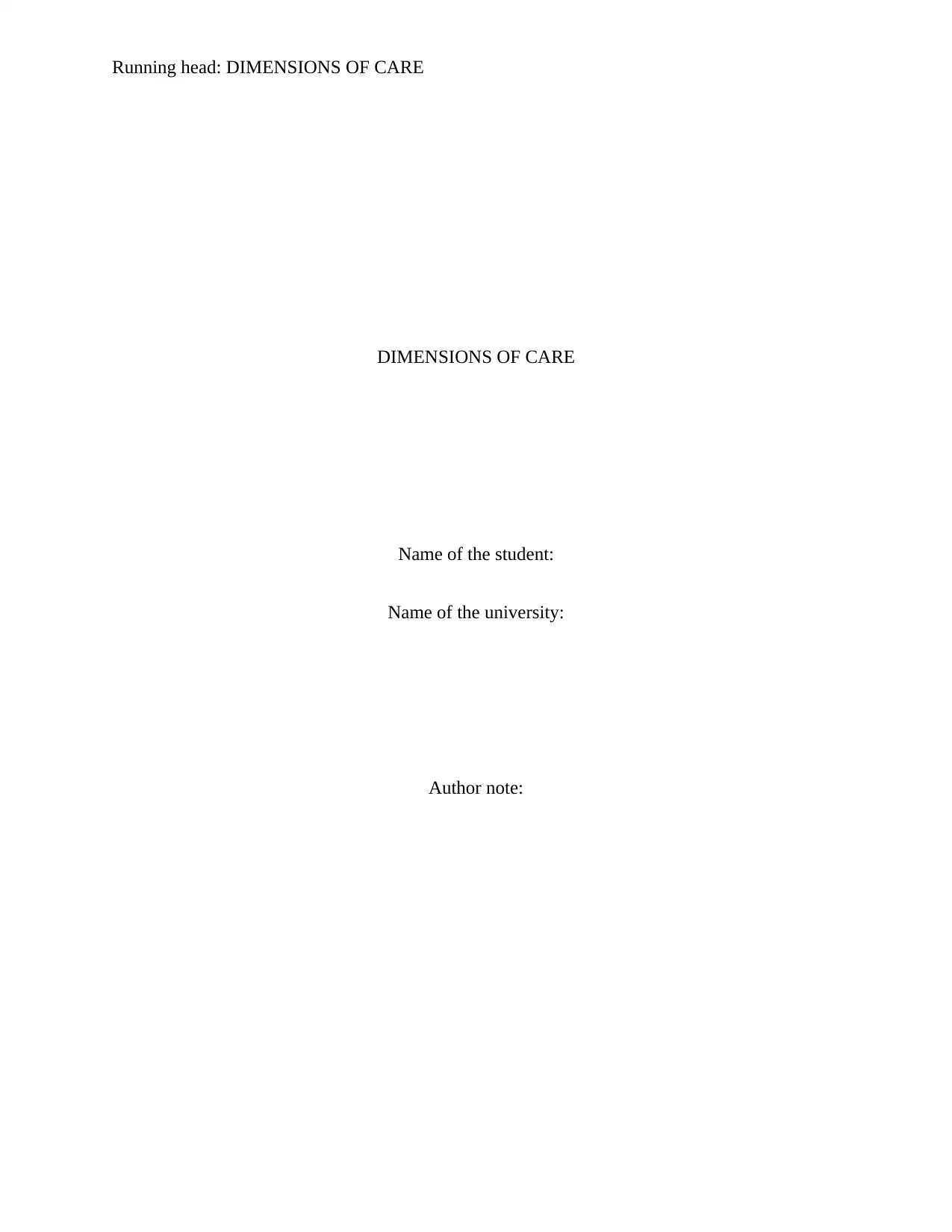
Running head: DIMENSIONS OF CARE
DIMENSIONS OF CARE
Name of the student:
Name of the university:
Author note:
DIMENSIONS OF CARE
Name of the student:
Name of the university:
Author note:
Paraphrase This Document
Need a fresh take? Get an instant paraphrase of this document with our AI Paraphraser
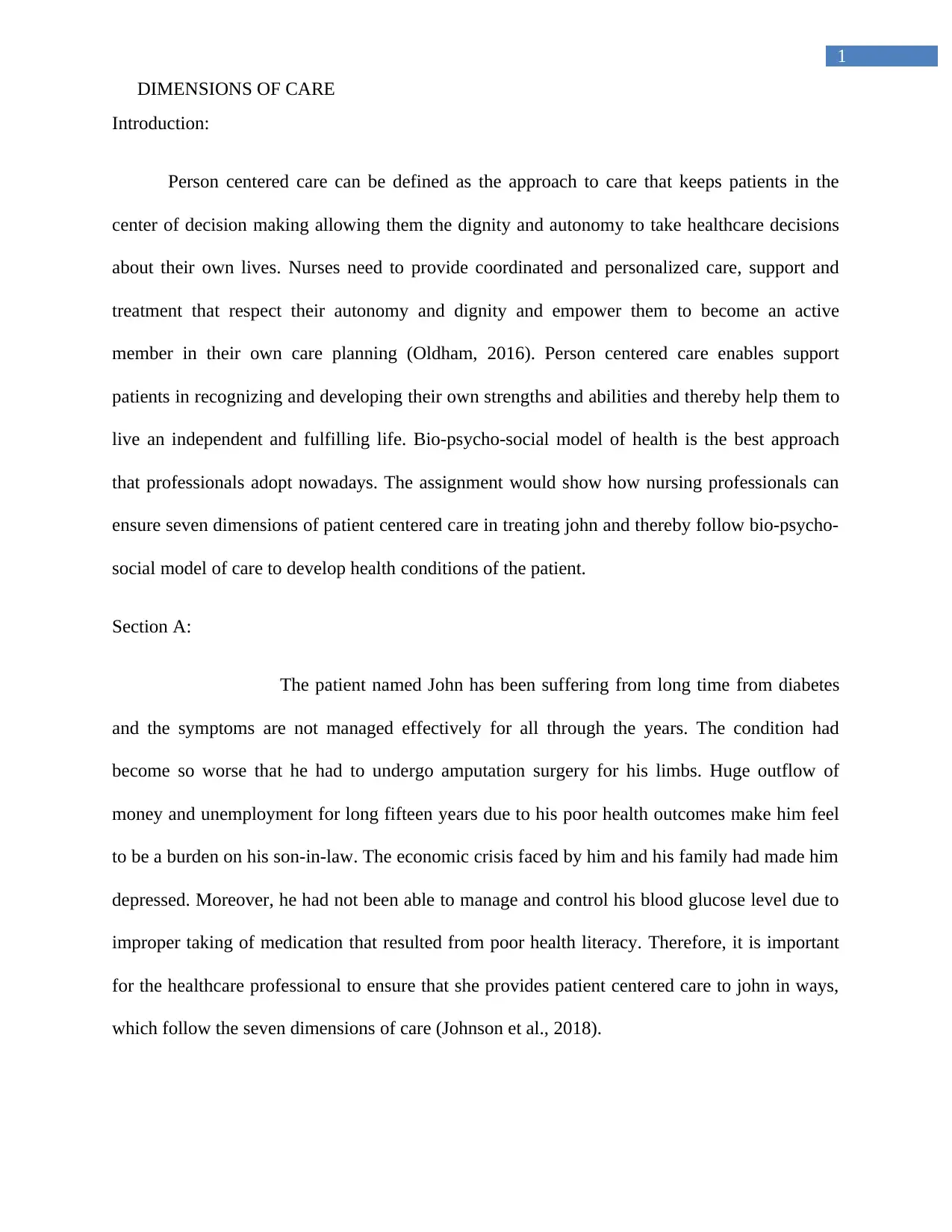
1
DIMENSIONS OF CARE
Introduction:
Person centered care can be defined as the approach to care that keeps patients in the
center of decision making allowing them the dignity and autonomy to take healthcare decisions
about their own lives. Nurses need to provide coordinated and personalized care, support and
treatment that respect their autonomy and dignity and empower them to become an active
member in their own care planning (Oldham, 2016). Person centered care enables support
patients in recognizing and developing their own strengths and abilities and thereby help them to
live an independent and fulfilling life. Bio-psycho-social model of health is the best approach
that professionals adopt nowadays. The assignment would show how nursing professionals can
ensure seven dimensions of patient centered care in treating john and thereby follow bio-psycho-
social model of care to develop health conditions of the patient.
Section A:
The patient named John has been suffering from long time from diabetes
and the symptoms are not managed effectively for all through the years. The condition had
become so worse that he had to undergo amputation surgery for his limbs. Huge outflow of
money and unemployment for long fifteen years due to his poor health outcomes make him feel
to be a burden on his son-in-law. The economic crisis faced by him and his family had made him
depressed. Moreover, he had not been able to manage and control his blood glucose level due to
improper taking of medication that resulted from poor health literacy. Therefore, it is important
for the healthcare professional to ensure that she provides patient centered care to john in ways,
which follow the seven dimensions of care (Johnson et al., 2018).
DIMENSIONS OF CARE
Introduction:
Person centered care can be defined as the approach to care that keeps patients in the
center of decision making allowing them the dignity and autonomy to take healthcare decisions
about their own lives. Nurses need to provide coordinated and personalized care, support and
treatment that respect their autonomy and dignity and empower them to become an active
member in their own care planning (Oldham, 2016). Person centered care enables support
patients in recognizing and developing their own strengths and abilities and thereby help them to
live an independent and fulfilling life. Bio-psycho-social model of health is the best approach
that professionals adopt nowadays. The assignment would show how nursing professionals can
ensure seven dimensions of patient centered care in treating john and thereby follow bio-psycho-
social model of care to develop health conditions of the patient.
Section A:
The patient named John has been suffering from long time from diabetes
and the symptoms are not managed effectively for all through the years. The condition had
become so worse that he had to undergo amputation surgery for his limbs. Huge outflow of
money and unemployment for long fifteen years due to his poor health outcomes make him feel
to be a burden on his son-in-law. The economic crisis faced by him and his family had made him
depressed. Moreover, he had not been able to manage and control his blood glucose level due to
improper taking of medication that resulted from poor health literacy. Therefore, it is important
for the healthcare professional to ensure that she provides patient centered care to john in ways,
which follow the seven dimensions of care (Johnson et al., 2018).
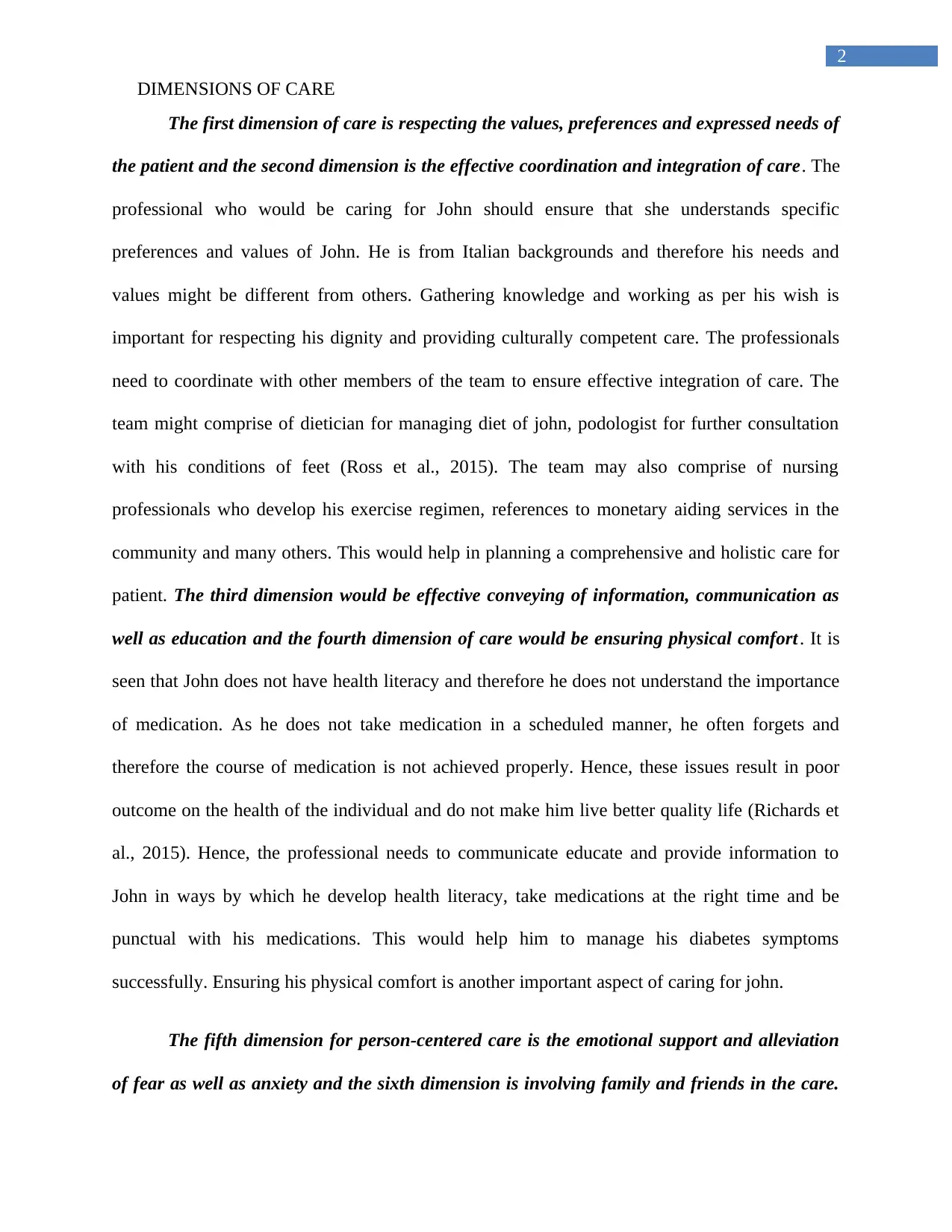
2
DIMENSIONS OF CARE
The first dimension of care is respecting the values, preferences and expressed needs of
the patient and the second dimension is the effective coordination and integration of care. The
professional who would be caring for John should ensure that she understands specific
preferences and values of John. He is from Italian backgrounds and therefore his needs and
values might be different from others. Gathering knowledge and working as per his wish is
important for respecting his dignity and providing culturally competent care. The professionals
need to coordinate with other members of the team to ensure effective integration of care. The
team might comprise of dietician for managing diet of john, podologist for further consultation
with his conditions of feet (Ross et al., 2015). The team may also comprise of nursing
professionals who develop his exercise regimen, references to monetary aiding services in the
community and many others. This would help in planning a comprehensive and holistic care for
patient. The third dimension would be effective conveying of information, communication as
well as education and the fourth dimension of care would be ensuring physical comfort. It is
seen that John does not have health literacy and therefore he does not understand the importance
of medication. As he does not take medication in a scheduled manner, he often forgets and
therefore the course of medication is not achieved properly. Hence, these issues result in poor
outcome on the health of the individual and do not make him live better quality life (Richards et
al., 2015). Hence, the professional needs to communicate educate and provide information to
John in ways by which he develop health literacy, take medications at the right time and be
punctual with his medications. This would help him to manage his diabetes symptoms
successfully. Ensuring his physical comfort is another important aspect of caring for john.
The fifth dimension for person-centered care is the emotional support and alleviation
of fear as well as anxiety and the sixth dimension is involving family and friends in the care.
DIMENSIONS OF CARE
The first dimension of care is respecting the values, preferences and expressed needs of
the patient and the second dimension is the effective coordination and integration of care. The
professional who would be caring for John should ensure that she understands specific
preferences and values of John. He is from Italian backgrounds and therefore his needs and
values might be different from others. Gathering knowledge and working as per his wish is
important for respecting his dignity and providing culturally competent care. The professionals
need to coordinate with other members of the team to ensure effective integration of care. The
team might comprise of dietician for managing diet of john, podologist for further consultation
with his conditions of feet (Ross et al., 2015). The team may also comprise of nursing
professionals who develop his exercise regimen, references to monetary aiding services in the
community and many others. This would help in planning a comprehensive and holistic care for
patient. The third dimension would be effective conveying of information, communication as
well as education and the fourth dimension of care would be ensuring physical comfort. It is
seen that John does not have health literacy and therefore he does not understand the importance
of medication. As he does not take medication in a scheduled manner, he often forgets and
therefore the course of medication is not achieved properly. Hence, these issues result in poor
outcome on the health of the individual and do not make him live better quality life (Richards et
al., 2015). Hence, the professional needs to communicate educate and provide information to
John in ways by which he develop health literacy, take medications at the right time and be
punctual with his medications. This would help him to manage his diabetes symptoms
successfully. Ensuring his physical comfort is another important aspect of caring for john.
The fifth dimension for person-centered care is the emotional support and alleviation
of fear as well as anxiety and the sixth dimension is involving family and friends in the care.
⊘ This is a preview!⊘
Do you want full access?
Subscribe today to unlock all pages.

Trusted by 1+ million students worldwide
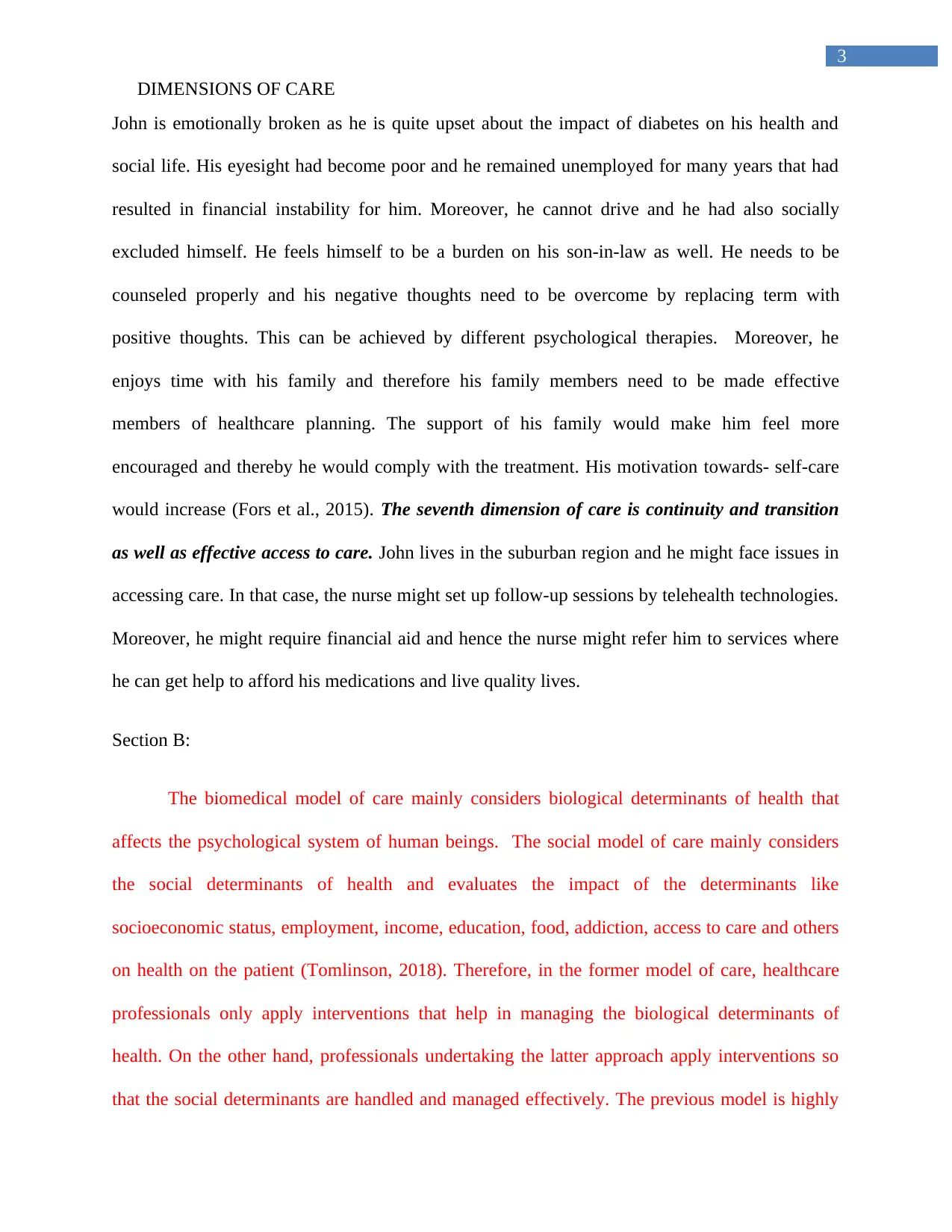
3
DIMENSIONS OF CARE
John is emotionally broken as he is quite upset about the impact of diabetes on his health and
social life. His eyesight had become poor and he remained unemployed for many years that had
resulted in financial instability for him. Moreover, he cannot drive and he had also socially
excluded himself. He feels himself to be a burden on his son-in-law as well. He needs to be
counseled properly and his negative thoughts need to be overcome by replacing term with
positive thoughts. This can be achieved by different psychological therapies. Moreover, he
enjoys time with his family and therefore his family members need to be made effective
members of healthcare planning. The support of his family would make him feel more
encouraged and thereby he would comply with the treatment. His motivation towards- self-care
would increase (Fors et al., 2015). The seventh dimension of care is continuity and transition
as well as effective access to care. John lives in the suburban region and he might face issues in
accessing care. In that case, the nurse might set up follow-up sessions by telehealth technologies.
Moreover, he might require financial aid and hence the nurse might refer him to services where
he can get help to afford his medications and live quality lives.
Section B:
The biomedical model of care mainly considers biological determinants of health that
affects the psychological system of human beings. The social model of care mainly considers
the social determinants of health and evaluates the impact of the determinants like
socioeconomic status, employment, income, education, food, addiction, access to care and others
on health on the patient (Tomlinson, 2018). Therefore, in the former model of care, healthcare
professionals only apply interventions that help in managing the biological determinants of
health. On the other hand, professionals undertaking the latter approach apply interventions so
that the social determinants are handled and managed effectively. The previous model is highly
DIMENSIONS OF CARE
John is emotionally broken as he is quite upset about the impact of diabetes on his health and
social life. His eyesight had become poor and he remained unemployed for many years that had
resulted in financial instability for him. Moreover, he cannot drive and he had also socially
excluded himself. He feels himself to be a burden on his son-in-law as well. He needs to be
counseled properly and his negative thoughts need to be overcome by replacing term with
positive thoughts. This can be achieved by different psychological therapies. Moreover, he
enjoys time with his family and therefore his family members need to be made effective
members of healthcare planning. The support of his family would make him feel more
encouraged and thereby he would comply with the treatment. His motivation towards- self-care
would increase (Fors et al., 2015). The seventh dimension of care is continuity and transition
as well as effective access to care. John lives in the suburban region and he might face issues in
accessing care. In that case, the nurse might set up follow-up sessions by telehealth technologies.
Moreover, he might require financial aid and hence the nurse might refer him to services where
he can get help to afford his medications and live quality lives.
Section B:
The biomedical model of care mainly considers biological determinants of health that
affects the psychological system of human beings. The social model of care mainly considers
the social determinants of health and evaluates the impact of the determinants like
socioeconomic status, employment, income, education, food, addiction, access to care and others
on health on the patient (Tomlinson, 2018). Therefore, in the former model of care, healthcare
professionals only apply interventions that help in managing the biological determinants of
health. On the other hand, professionals undertaking the latter approach apply interventions so
that the social determinants are handled and managed effectively. The previous model is highly
Paraphrase This Document
Need a fresh take? Get an instant paraphrase of this document with our AI Paraphraser
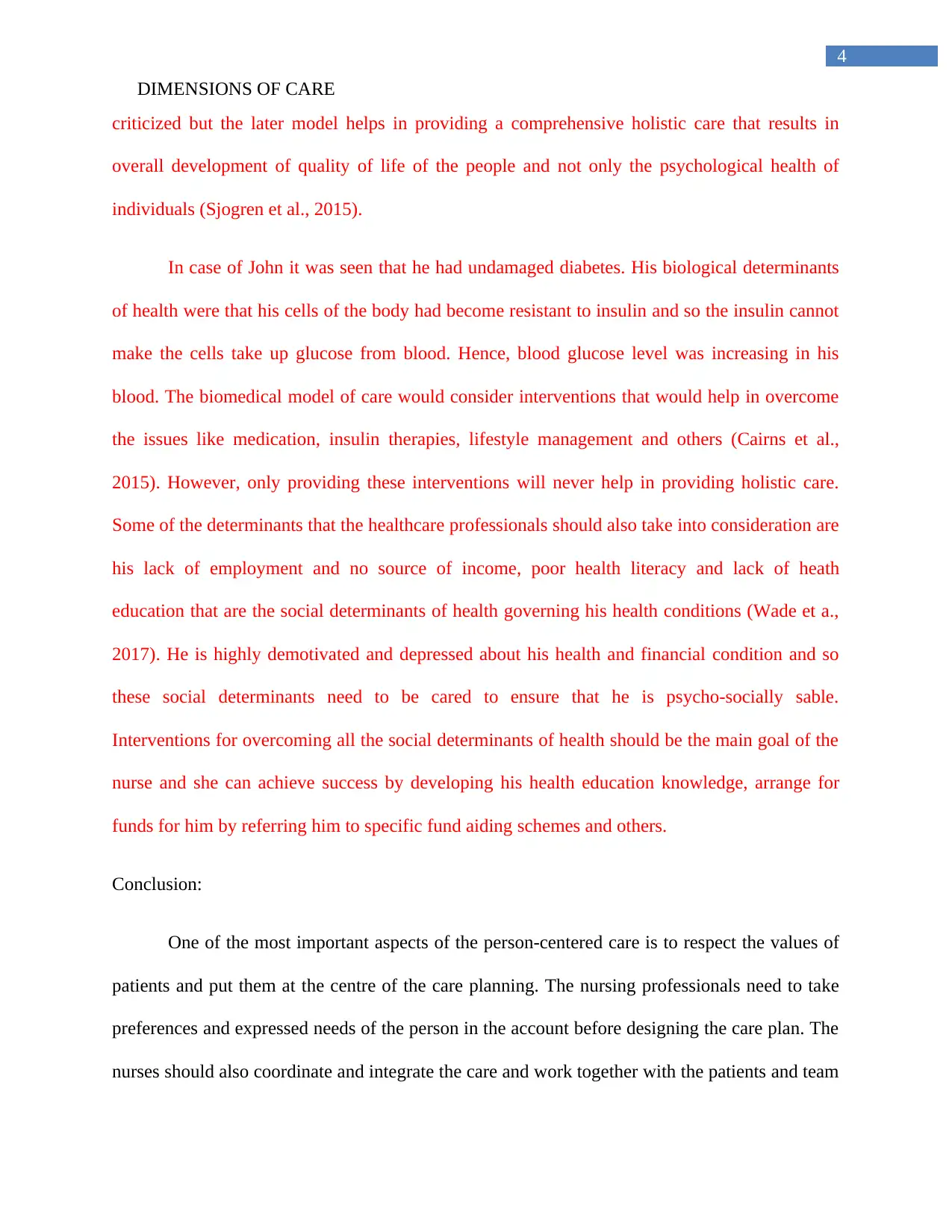
4
DIMENSIONS OF CARE
criticized but the later model helps in providing a comprehensive holistic care that results in
overall development of quality of life of the people and not only the psychological health of
individuals (Sjogren et al., 2015).
In case of John it was seen that he had undamaged diabetes. His biological determinants
of health were that his cells of the body had become resistant to insulin and so the insulin cannot
make the cells take up glucose from blood. Hence, blood glucose level was increasing in his
blood. The biomedical model of care would consider interventions that would help in overcome
the issues like medication, insulin therapies, lifestyle management and others (Cairns et al.,
2015). However, only providing these interventions will never help in providing holistic care.
Some of the determinants that the healthcare professionals should also take into consideration are
his lack of employment and no source of income, poor health literacy and lack of heath
education that are the social determinants of health governing his health conditions (Wade et a.,
2017). He is highly demotivated and depressed about his health and financial condition and so
these social determinants need to be cared to ensure that he is psycho-socially sable.
Interventions for overcoming all the social determinants of health should be the main goal of the
nurse and she can achieve success by developing his health education knowledge, arrange for
funds for him by referring him to specific fund aiding schemes and others.
Conclusion:
One of the most important aspects of the person-centered care is to respect the values of
patients and put them at the centre of the care planning. The nursing professionals need to take
preferences and expressed needs of the person in the account before designing the care plan. The
nurses should also coordinate and integrate the care and work together with the patients and team
DIMENSIONS OF CARE
criticized but the later model helps in providing a comprehensive holistic care that results in
overall development of quality of life of the people and not only the psychological health of
individuals (Sjogren et al., 2015).
In case of John it was seen that he had undamaged diabetes. His biological determinants
of health were that his cells of the body had become resistant to insulin and so the insulin cannot
make the cells take up glucose from blood. Hence, blood glucose level was increasing in his
blood. The biomedical model of care would consider interventions that would help in overcome
the issues like medication, insulin therapies, lifestyle management and others (Cairns et al.,
2015). However, only providing these interventions will never help in providing holistic care.
Some of the determinants that the healthcare professionals should also take into consideration are
his lack of employment and no source of income, poor health literacy and lack of heath
education that are the social determinants of health governing his health conditions (Wade et a.,
2017). He is highly demotivated and depressed about his health and financial condition and so
these social determinants need to be cared to ensure that he is psycho-socially sable.
Interventions for overcoming all the social determinants of health should be the main goal of the
nurse and she can achieve success by developing his health education knowledge, arrange for
funds for him by referring him to specific fund aiding schemes and others.
Conclusion:
One of the most important aspects of the person-centered care is to respect the values of
patients and put them at the centre of the care planning. The nursing professionals need to take
preferences and expressed needs of the person in the account before designing the care plan. The
nurses should also coordinate and integrate the care and work together with the patients and team
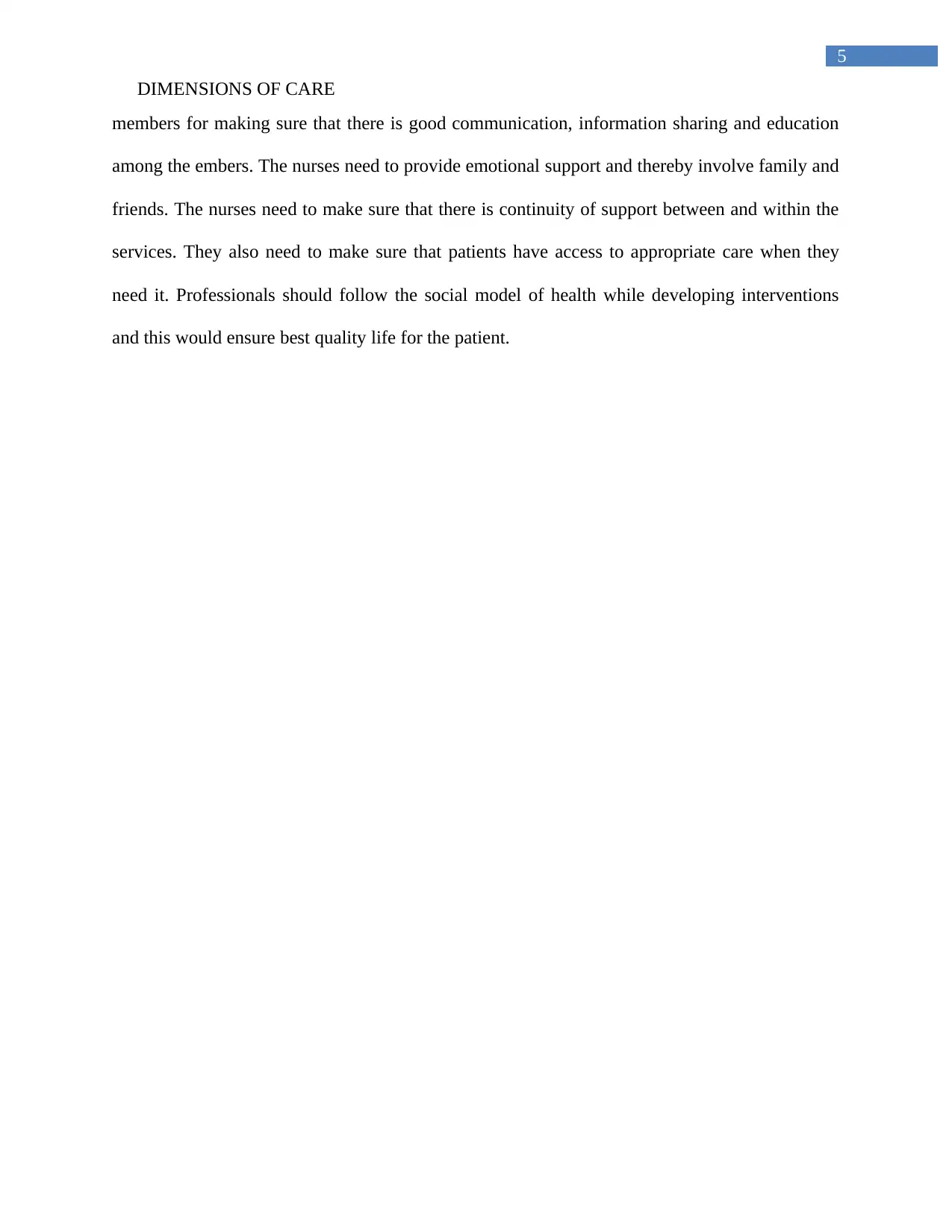
5
DIMENSIONS OF CARE
members for making sure that there is good communication, information sharing and education
among the embers. The nurses need to provide emotional support and thereby involve family and
friends. The nurses need to make sure that there is continuity of support between and within the
services. They also need to make sure that patients have access to appropriate care when they
need it. Professionals should follow the social model of health while developing interventions
and this would ensure best quality life for the patient.
DIMENSIONS OF CARE
members for making sure that there is good communication, information sharing and education
among the embers. The nurses need to provide emotional support and thereby involve family and
friends. The nurses need to make sure that there is continuity of support between and within the
services. They also need to make sure that patients have access to appropriate care when they
need it. Professionals should follow the social model of health while developing interventions
and this would ensure best quality life for the patient.
⊘ This is a preview!⊘
Do you want full access?
Subscribe today to unlock all pages.

Trusted by 1+ million students worldwide
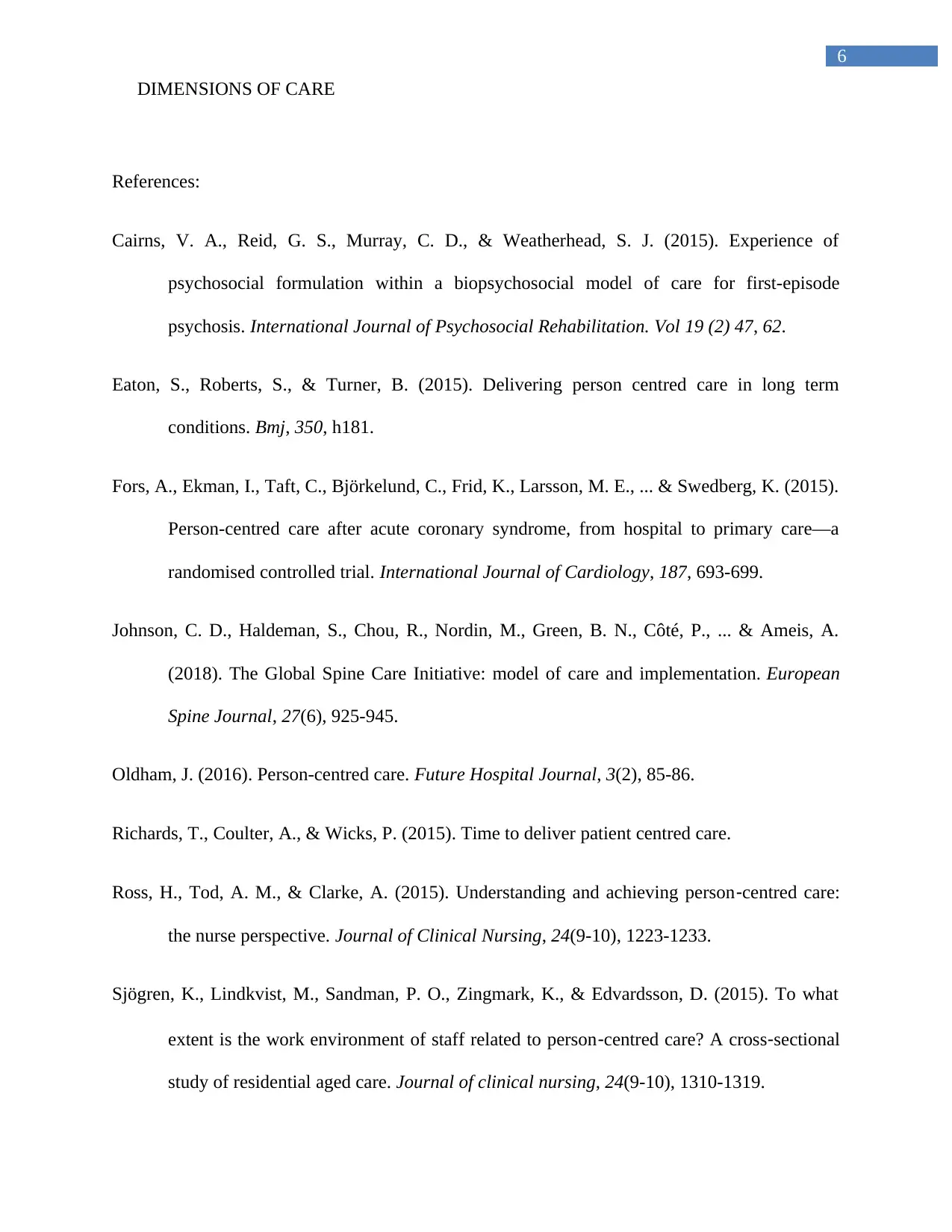
6
DIMENSIONS OF CARE
References:
Cairns, V. A., Reid, G. S., Murray, C. D., & Weatherhead, S. J. (2015). Experience of
psychosocial formulation within a biopsychosocial model of care for first-episode
psychosis. International Journal of Psychosocial Rehabilitation. Vol 19 (2) 47, 62.
Eaton, S., Roberts, S., & Turner, B. (2015). Delivering person centred care in long term
conditions. Bmj, 350, h181.
Fors, A., Ekman, I., Taft, C., Björkelund, C., Frid, K., Larsson, M. E., ... & Swedberg, K. (2015).
Person-centred care after acute coronary syndrome, from hospital to primary care—a
randomised controlled trial. International Journal of Cardiology, 187, 693-699.
Johnson, C. D., Haldeman, S., Chou, R., Nordin, M., Green, B. N., Côté, P., ... & Ameis, A.
(2018). The Global Spine Care Initiative: model of care and implementation. European
Spine Journal, 27(6), 925-945.
Oldham, J. (2016). Person-centred care. Future Hospital Journal, 3(2), 85-86.
Richards, T., Coulter, A., & Wicks, P. (2015). Time to deliver patient centred care.
Ross, H., Tod, A. M., & Clarke, A. (2015). Understanding and achieving person‐centred care:
the nurse perspective. Journal of Clinical Nursing, 24(9-10), 1223-1233.
Sjögren, K., Lindkvist, M., Sandman, P. O., Zingmark, K., & Edvardsson, D. (2015). To what
extent is the work environment of staff related to person‐centred care? A cross‐sectional
study of residential aged care. Journal of clinical nursing, 24(9-10), 1310-1319.
DIMENSIONS OF CARE
References:
Cairns, V. A., Reid, G. S., Murray, C. D., & Weatherhead, S. J. (2015). Experience of
psychosocial formulation within a biopsychosocial model of care for first-episode
psychosis. International Journal of Psychosocial Rehabilitation. Vol 19 (2) 47, 62.
Eaton, S., Roberts, S., & Turner, B. (2015). Delivering person centred care in long term
conditions. Bmj, 350, h181.
Fors, A., Ekman, I., Taft, C., Björkelund, C., Frid, K., Larsson, M. E., ... & Swedberg, K. (2015).
Person-centred care after acute coronary syndrome, from hospital to primary care—a
randomised controlled trial. International Journal of Cardiology, 187, 693-699.
Johnson, C. D., Haldeman, S., Chou, R., Nordin, M., Green, B. N., Côté, P., ... & Ameis, A.
(2018). The Global Spine Care Initiative: model of care and implementation. European
Spine Journal, 27(6), 925-945.
Oldham, J. (2016). Person-centred care. Future Hospital Journal, 3(2), 85-86.
Richards, T., Coulter, A., & Wicks, P. (2015). Time to deliver patient centred care.
Ross, H., Tod, A. M., & Clarke, A. (2015). Understanding and achieving person‐centred care:
the nurse perspective. Journal of Clinical Nursing, 24(9-10), 1223-1233.
Sjögren, K., Lindkvist, M., Sandman, P. O., Zingmark, K., & Edvardsson, D. (2015). To what
extent is the work environment of staff related to person‐centred care? A cross‐sectional
study of residential aged care. Journal of clinical nursing, 24(9-10), 1310-1319.
Paraphrase This Document
Need a fresh take? Get an instant paraphrase of this document with our AI Paraphraser
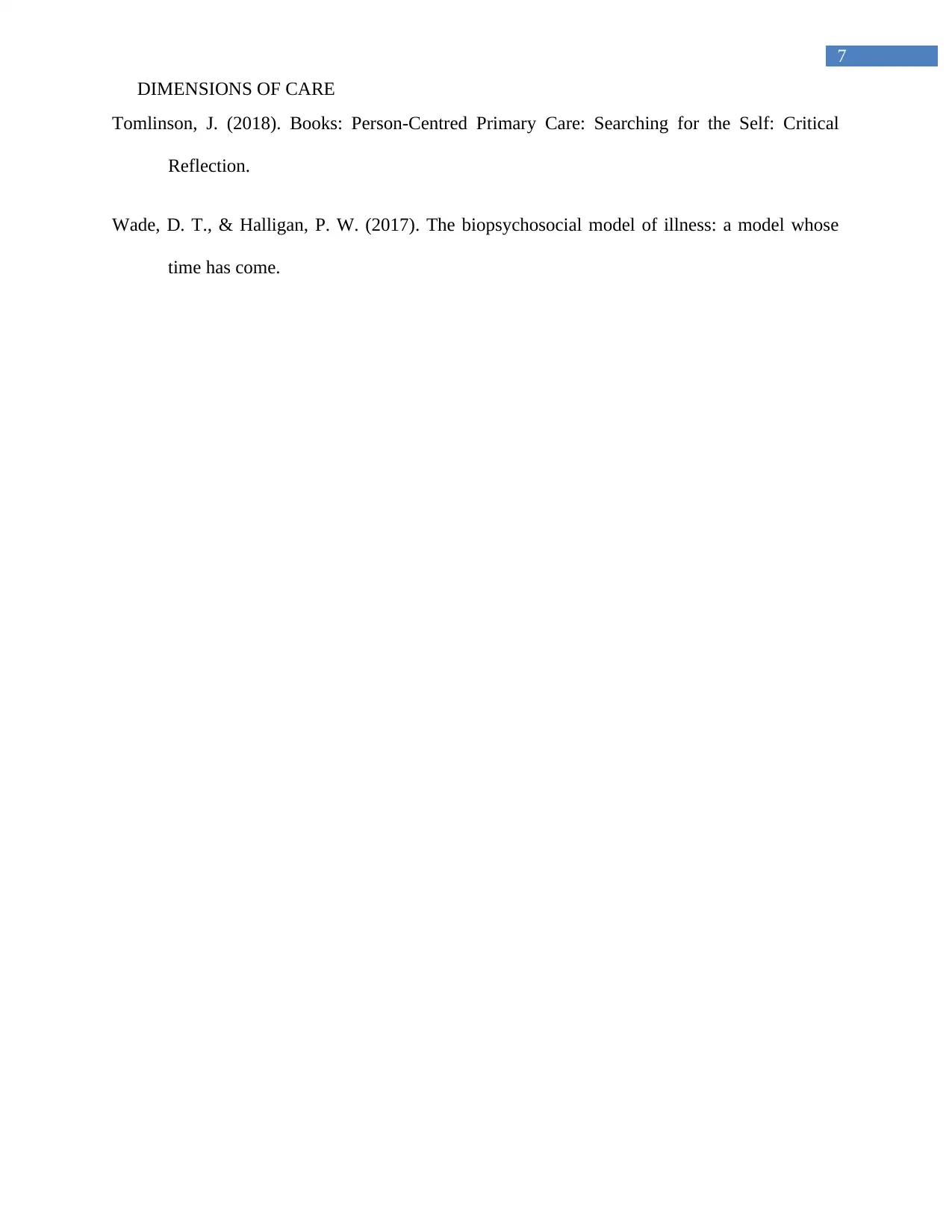
7
DIMENSIONS OF CARE
Tomlinson, J. (2018). Books: Person-Centred Primary Care: Searching for the Self: Critical
Reflection.
Wade, D. T., & Halligan, P. W. (2017). The biopsychosocial model of illness: a model whose
time has come.
DIMENSIONS OF CARE
Tomlinson, J. (2018). Books: Person-Centred Primary Care: Searching for the Self: Critical
Reflection.
Wade, D. T., & Halligan, P. W. (2017). The biopsychosocial model of illness: a model whose
time has come.
1 out of 8
Related Documents
Your All-in-One AI-Powered Toolkit for Academic Success.
+13062052269
info@desklib.com
Available 24*7 on WhatsApp / Email
![[object Object]](/_next/static/media/star-bottom.7253800d.svg)
Unlock your academic potential
Copyright © 2020–2025 A2Z Services. All Rights Reserved. Developed and managed by ZUCOL.





